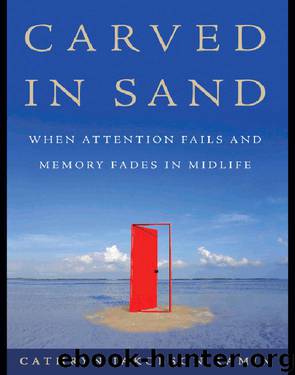Carved in Sand by Cathryn Jakobson Ramin

Author:Cathryn Jakobson Ramin
Language: eng
Format: epub
Publisher: HarperCollins
SLEEPING AT STANFORD
I’d made an appointment to see Tracy Kuo, a psychologist at the Stanford University Sleep Disorder Center, who specializes in behavioral sleep medicine. Sleep medicine, which scientists at Stanford pioneered, is over three decades old, but Kuo’s discipline—sleep psychology—is embryonic. (Given the statistics on sleeplessness, it’s no surprise that private sleep-medicine clinics are burgeoning. The majority of these clinics are run by neurologists and pulmonary specialists who address sleep-related troubles like obstructive sleep apnea, restless leg syndrome and periodic movement disorder. At least until recently, doctors at these clinics held that insomnia did not exist as an independent condition, but instead emerged from depression, pain or some other disorder.)
In 2000, Kuo came to Stanford as a postdoc. She was fresh out of Richard Bootzin’s lab at the University of Arizona. Bootzin, a professor of psychology and psychiatry at the Arizona Sleep Center, and his colleagues took a different view of chronic insomnia. They saw it as a twenty-four-hour physiological problem with a strong psychological component. Instead of growing sleepy at bedtime, Bootzin observed, insomniacs became agitated. Their adrenaline and cortisol levels shot up. Their hearts beat faster. He called it “conditioned hyperarousal.” Sending them to bed at a “decent” hour to get a good night’s sleep was not the solution. More hours in bed were the last thing an insomniac needed. Bootzin and his investigators (among them, Tracy Kuo) hypothesized that the answer resided instead in sleep restriction—drastically limiting the time a person spent in bed, until the body’s homeostatic demand for sleep took over and normal circadian rhythms emerged, maybe for the first time in years. In Bootzin’s lab, the principles of cognitive behavioral therapy for insomnia—CBT-I—evolved. Kuo packed them up and took them to Stanford, where she’s continued to hone them for half a decade.
Cognitive behavioral therapy is used to treat a variety of problems, including obsessive-compulsive disorders and many types of phobias. The idea behind CBT is quite simple: Alter the behavior that causes the disorder (no more hand washing or flicking of light switches) and the disorder will go away.
CBT-I is so rigorous that a patient must be highly motivated. One study of CBT-I programs showed that 30 percent of patients dropped out in the first few weeks. It’s easy to see why. In the beginning, the time you’re permitted to sleep is often reduced to the bare minimum—around two hundred minutes, or just over three hours. When you sleep 90 percent of that time, you are allowed to add time, in fifteen-minute increments. In theory, it’s possible to do CBT-I on your own. You could set up a schedule and stick with it. But I knew that I wouldn’t be able to pull it off without one hell of a cheerleader on my side.
Within a few minutes of meeting Tracy Kuo at Stanford, I knew I had one. Her patients, several of whom had taken the time to speak to me, referred to her as “the goddess of sleep,” which led me to expect someone tall, stately and dressed (appropriately enough) in a bed-sheet.
Download
This site does not store any files on its server. We only index and link to content provided by other sites. Please contact the content providers to delete copyright contents if any and email us, we'll remove relevant links or contents immediately.
A Mind For Numbers: How to Excel at Math and Science (Even If You Flunked Algebra) by Barbara Oakley(2692)
Limitless by Jim Kwik(2625)
Fluent Forever: How to Learn Any Language Fast and Never Forget It by Gabriel Wyner(2449)
The Marketing Plan Handbook: Develop Big-Picture Marketing Plans for Pennies on the Dollar by Robert W. Bly(2417)
Remember It! by Nelson Dellis(2227)
The Mind Map Book by Tony Buzan(2086)
Memory Rescue by Daniel G. Amen(1963)
The Memory Code by Lynne Kelly(1951)
Super Reading Secrets by Howard Stephen Berg(1711)
Boost Your Brain Power in 60 Seconds by Michelle Schoffro Cook(1679)
Memory Rescue: Supercharge Your Brain, Reverse Memory Loss, and Remember What Matters Most by Amen Dr. Daniel G(1572)
Brain Training: How To Learn and Remember Everything (Neuro Linguistic Programming, Remember Everything, Increase memory, How To Remember Book 1) by Lynch George(1497)
How We Learn: The Surprising Truth About When, Where, and Why It Happens by Carey Benedict(1459)
You Can Have an Amazing Memory by Dominic O'Brien(1413)
The Mechanism of Mind: Understand how your mind works to maximise memory and creative potential by Edward de Bono(1351)
The Brain Boost Diet Plan by Christine Bailey(1314)
How to Develop a Perfect Memory by Dominic O'Brien(1249)
Brain Builders by Frank M.D. Minirth(1219)
Master Your Memory by Ron Fry(1216)
